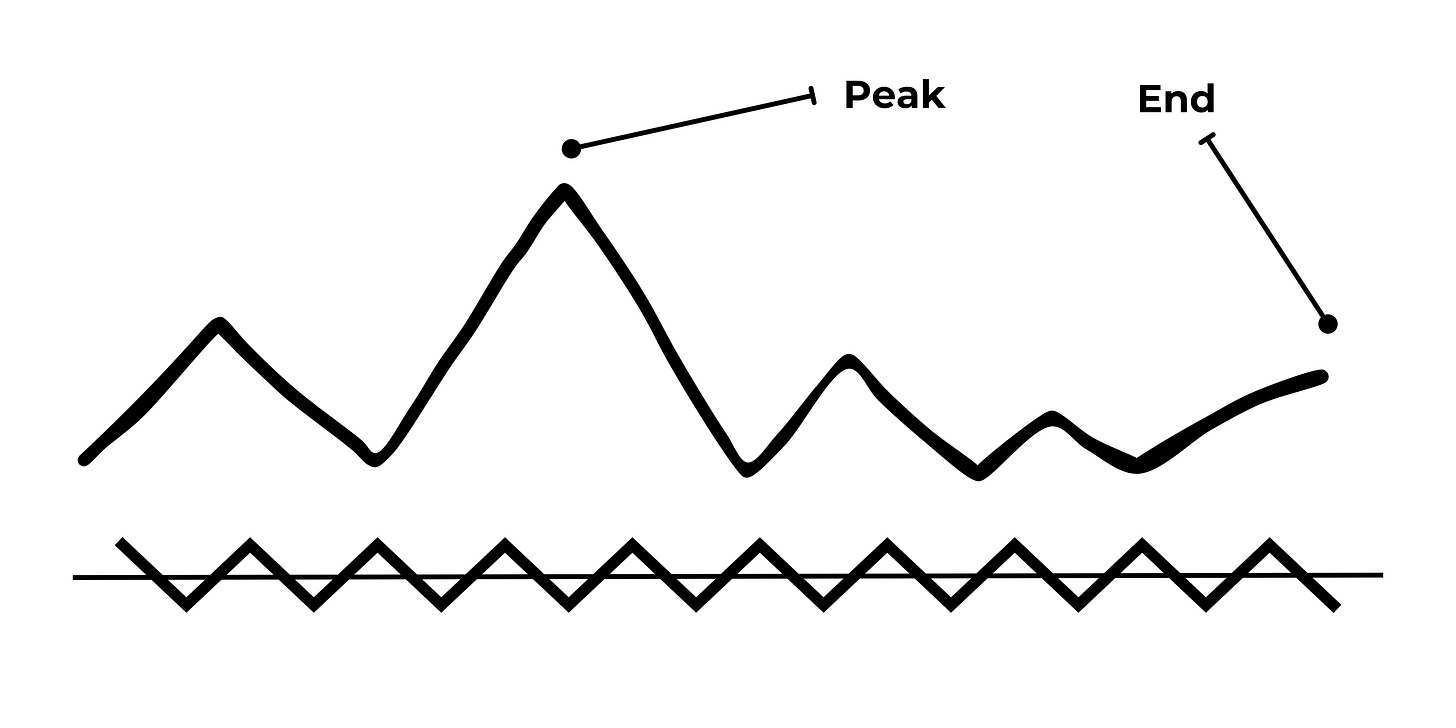What is a “psychological moonshot”?
“Psychological moonshot,” a term coined by Ogilvy’s Rory Sutherland, is a relatively small investment that drastically improves the perception of something. Psychological moonshots are often small, free, or superficial changes to your product or service that create a huge perceived value in your customers' minds.ur customer’s mind.
In Sutherland’s words:
It’s hard to increase customer satisfaction by making a train ten times faster; it’s much easier to increase customer satisfaction by using psychological principles to make it feel ten times more enjoyable.
In this chapter, Bartlett lists out five psychological effects discovered by Uber Labs (Uber’s in-house team of data scientists, psychologists, and neuroscientists):
1. The Peak-End Rule
The peak-end rule is a cognitive bias that describes how people remember an experience or an event. Simply put, people will judge an experience by the best or worst part (the “peak”) and the end.
Real-life examples of the peak-end rule:
Why a terrible flight at the end of an amazing vacation can ruin your perception of the entire experience
Why Uber drivers are trained to be exceptionally kind and polite to you at the end of a ride, just moments before you rate them and give them a tip

Main Principle: Pay special attention to the peak and final moments of your product or service experience.
How can you make sure the peak is a positive experience?
How can you prevent or minimize a negative peak?
How can you end the experience on a positive high note?
2. Idleness Aversion
Uber Labs found that people who are busy are happier than people who are idle. The implications of this research are that many of the activities and behaviors we take part in on a daily basis are mainly to keep us busy and moving. Uber’s researchers made a fascinating discovery: most people would rather choose to wait a long time as long as they have something to do than wait a short period of time with nothing to do.
Real-life examples of idleness aversion
After you book an Uber ride, the app shows you a map with your Uber gradually moving closer to you.
Why do restaurants bring you free bread or appetizers while you wait for your meal?
Why Netflix and Youtube show you previews and trailers while you’re searching for something to watch
Main Principle: Don’t let your customers get bored or idle. Keep them busy or distracted somehow.
3. Operational Transparency
Lack of transparency is extremely damaging to the customer experience, building skepticism and trust in the customer’s mind. Along these lines, Uber began using a psychology principle called “operational transparency” to give customers a behind-the-scenes look into how the ride fares were being calculated, including the time estimate calculation, fare breakdowns, justified estimates, and quick updates when something changed. By being transparent with customers, Uber reduced the perception of “shenanigans” in the customers minds.
Main Principle: Be as transparent as possible with the aspects of your business that are meaningful to your customers.
4. Uncertainty Anxiety
Research published in the journal Nature demonstrated that it’s less psychologically stressful to know something negative is about to happen than to be left in uncertainty.
Real-life examples of uncertainty
Domino’s Pizza Tracker order-management software that shows customers exactly where their pizza order is in a five-step process. Prior to this, customers who were waiting longer than expected for their order (uncertainty of when the pizza would be ready) would call the Domino’s store, disrupting the entire pizza production process in the kitchen.
A “Delayed” alert on your scheduled flight is much more aggravating than a “Delayed 50 minutes” alert.
Main Principle: Uncertainty is bad for the customer experience.
5. The Goal-Gradient Effect
The goal-gradient effect, initially discovered in 1932, shows how we get more motivated the closer we are to success or achieving a goal.
Real-life examples of idleness aversion
Customers collecting stamps for a coffee shop’s reward program buy more coffee the closer they get to earning a free drink.
LinkedIn users are more likely to add profile information if they’re shown a “profile strength” bar.
Uber’s map will continue to zoom in, emphasizing how close your Uber is to arriving.
Main Principle: Motivate customers by showing that they are close to achieving some target or goal.




